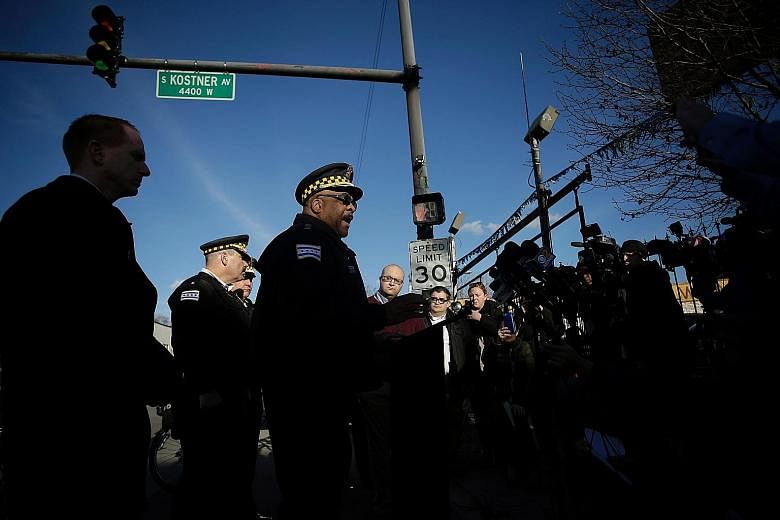Chicago's skyrocketing homicide rate regularly grabs headlines. Last Wednesday, seven people, including a pregnant woman, were killed, prompting President Donald Trump to tweet: "Seven people shot and killed yesterday in Chicago. What is going on there - totally out of control. Chicago needs help!"
The mayhem fed straight into the President's "American carnage" narrative in his inaugural speech, which has sparked vigorous debate.
In the speech on Jan 20, the newly sworn-in President spoke of "mothers and children trapped in poverty in our inner cities; rusted-out factories scattered like tombstones across the landscape of our nation; an education system flush with cash, but which leaves our young and beautiful students deprived of all knowledge; and the crime and the gangs and the drugs that have stolen too many lives and robbed our country of so much unrealised potential".
The New York Times called it a "uniquely dark vision of the US". The Washington Post reported that "Trump delivered a dark inaugural address".
The US does have the highest gun-related homicide rate among high-income countries.
-
WHERE AMERICA STANDS NOW
43.1 million
Number of Americans living in poverty, according to US census data.
5 per 100,000
Today's national murder rate, down from about 10 per 100,000 in the 1980s and 1990s.
In March last year, the American Journal of Medicine (AMJ) concluded that "US homicide rates were seven times higher than in other high-income countries, driven by a gun homicide rate that was 25.2 times higher".
For 15- to 24-year-olds, the gun homicide rate in the United States was 49 times higher.
According to the AMJ, the total homicide rate in 2010 in the US was 5.3 per 100,000 people, compared with Germany's 0.6 and Japan's and Britain's 0.3.
The World Bank lists Japan and Singapore at zero homicides per 100,000 in 2014.
The big difference between the US and most other countries is that gun ownership is widespread in the US because it is a constitutional right to own a gun.
Guns and poverty are also a lethal combination. A total of 43.1 million Americans were officially living in poverty in 2015 according to the US Census Bureau - a fact often referenced by President Trump in his campaign when he said 43 million relied on food stamps from the government.
Census data also showed that between 2007 - when the recession began - and 2015, 18.1 per cent of counties saw an increase in poverty, while 2 per cent saw a decrease.
But crime rates vary from city to city, and from district to district within cities - often reflecting the reality of an America segregated by race and social and economic status.
New York, a city of eight million, is safer today. Last year, it recorded 998 shootings, a 12 per cent decline from 2015. Homicides fell to 335 from 352 in 2015.
Chicago's alarming homicide rate is overwhelmingly concentrated in just five of 22 police districts - which happen to be predominantly African American, with some percentage Latino. But that is also nothing new.
Baltimore, a city of 622,000 people, recorded the second most violent year in its history, with 216 homicides. But again, while the violence did occur in normally quiet enclaves across the city, it was "mostly in the same downtrodden neighbourhoods time and again", the Baltimore Sun newspaper reported last month.
Not surprisingly, an August 2016 Department of Justice report on the Baltimore Police found that roughly 44 per cent of its stops - to check on people - were in "two small, predominantly African-American districts that contain only 11 per cent of the city's population".
Meanwhile, New Orleans, a city of less than half a million, is "currently on pace for 230 murders in 2017. It's still early in the year, but that would be the most murders here since 2004", crime analyst Jeff Asher tweeted on Friday.
Mr Rob Paral, Chicago-based consultant and urban demographics expert, said it's not as simple as Mr Trump makes it seem.
"American carnage is one particular reality, but it's complicated. These things (drugs and crime) have been going on for decades. You can always find contradictions.
"But President Trump and White House Chief Strategist Steve Bannon don't deal in contradictions. You don't organise people with contradictions, you organise people with simplicity," he told The Sunday Times in an interview.
He added: "There have been a lot of killings in Chicago but the rate is still the lowest it's been in years. The neighbourhoods are safer - not to say they are safe, but the trend is good. Trump is making it sound worse than it is."
New Orleans-based crime statistics analyst Jeff Asher agrees. "President Trump's take was a simplistic one, on a very complicated issue. Just calling it 'American carnage' doesn't do justice and doesn't necessarily help us understand the situation," he told The Sunday Times over the phone.
He said analysts like him who monitor the developments are concerned over the "unexplained" increase in crime in some areas over the last two years.
"But it's irresponsible not to acknowledge where the country stands right now. The national murder rate is cut in half from about 10 per 100,000 in the 1980s and 1990s, to about five per 100,000 now. That's progress. Just because we've had two bad years doesn't mean we can ignore the progress," he said.

